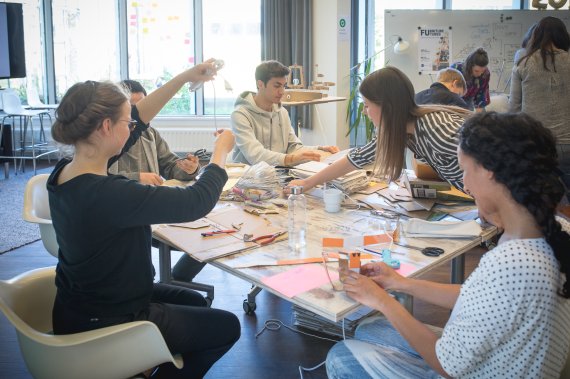© Sven Menschel
The CESH students want to encourage the transition to a biobased, circular economy in which materials are reused as much as possible. They see a role here for research and education. This year, CESH chose furniture as its theme. WUR student Elke Sauter from CESH says this is an important topic because of the new teaching buildings and the growth in the number of students in Wageningen. Student flats have a big turnover and students don’t always take the furniture with them.
To get the debate about furniture waste going among students, furniture makers and second-hand shops, CESH had a discussion panel with representatives from Flokk Nederland (a circular-economy furniture manufacturer), Herso (which makes furniture from second-hand wood), Emmaus Wageningen (a second-hand shop) and the Forum library (which used circular-economy furniture in its renovation).
The panel members talked about consumers’ attitudes to sustainability and how their company or organization contributes towards a more circular economy. For example, Rick Ruigrok from Herso said they had not bought any new material for 18 years. Petra Otten from the library said that when the library was renovated, they aimed to reuse the existing furniture. Furniture that was no longer functional was sold to circular-economy buyers, and they had a strict list of requirements for the new furniture they purchased.
 As a group, they saw big opportunities for improvement at the stage when furniture breaks and is thrown away. Products should already be designed for reuse in the manufacturing stage, for example by making sure that parts can be replaced (so that you don’t have to discard the entire product)
As a group, they saw big opportunities for improvement at the stage when furniture breaks and is thrown away. Products should already be designed for reuse in the manufacturing stage, for example by making sure that parts can be replaced (so that you don’t have to discard the entire product)
and that those parts can be recycled. Both businesses and students should take this into account.
Co-organizer Sauter acknowledges that there is a long way to go before furniture is part of the circular economy. For instance, how do you connect up the different parties involved in the process and make sure that the waste produced by one party becomes the raw material for another? ‘My dream is to have a kind of database for this,’ says Sauter.
At the end, students got the opportunity to craft a cardboard lamp. That was actually what most of the 15 students attending the event had come for — to do something creative during this self-study week.

